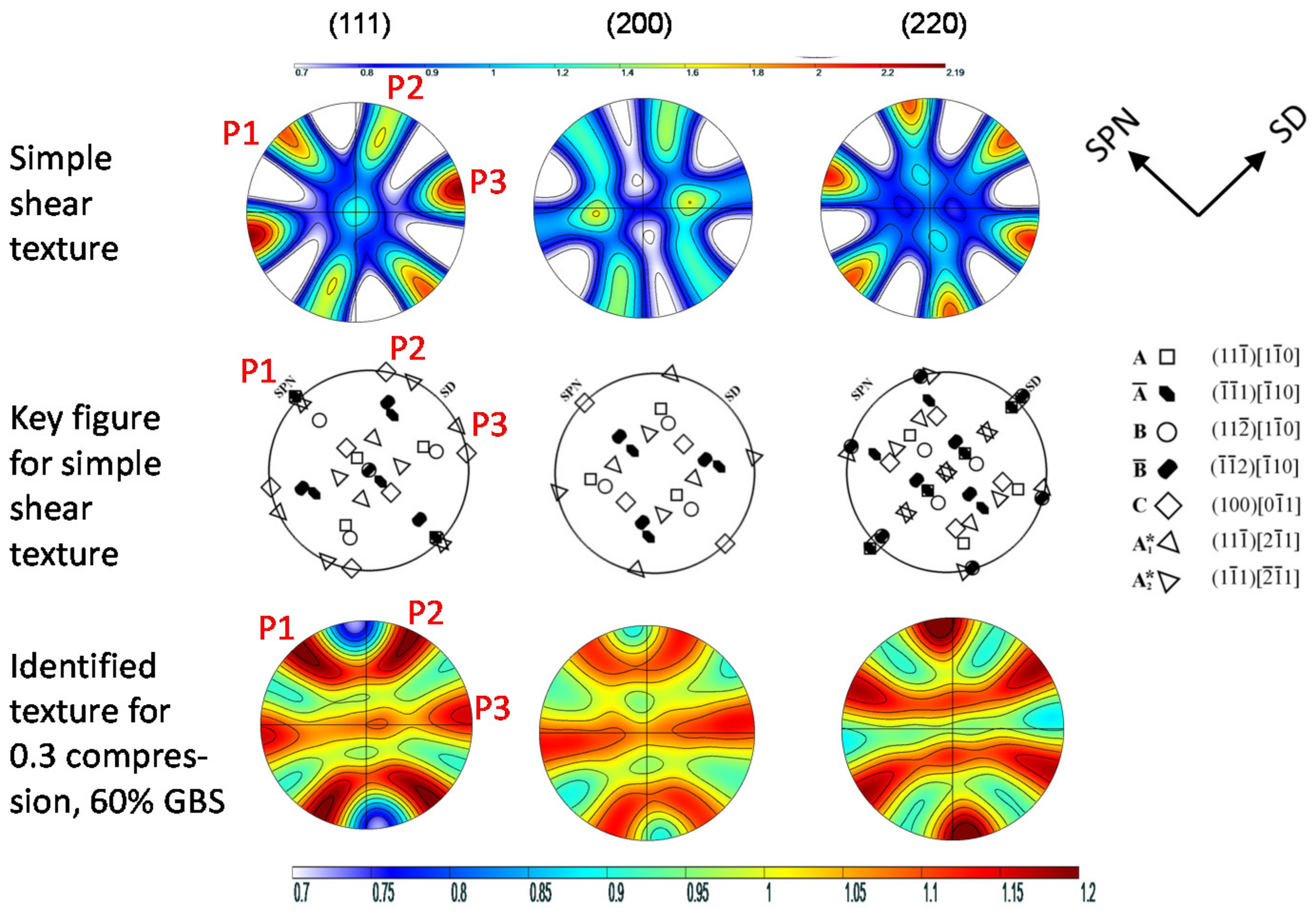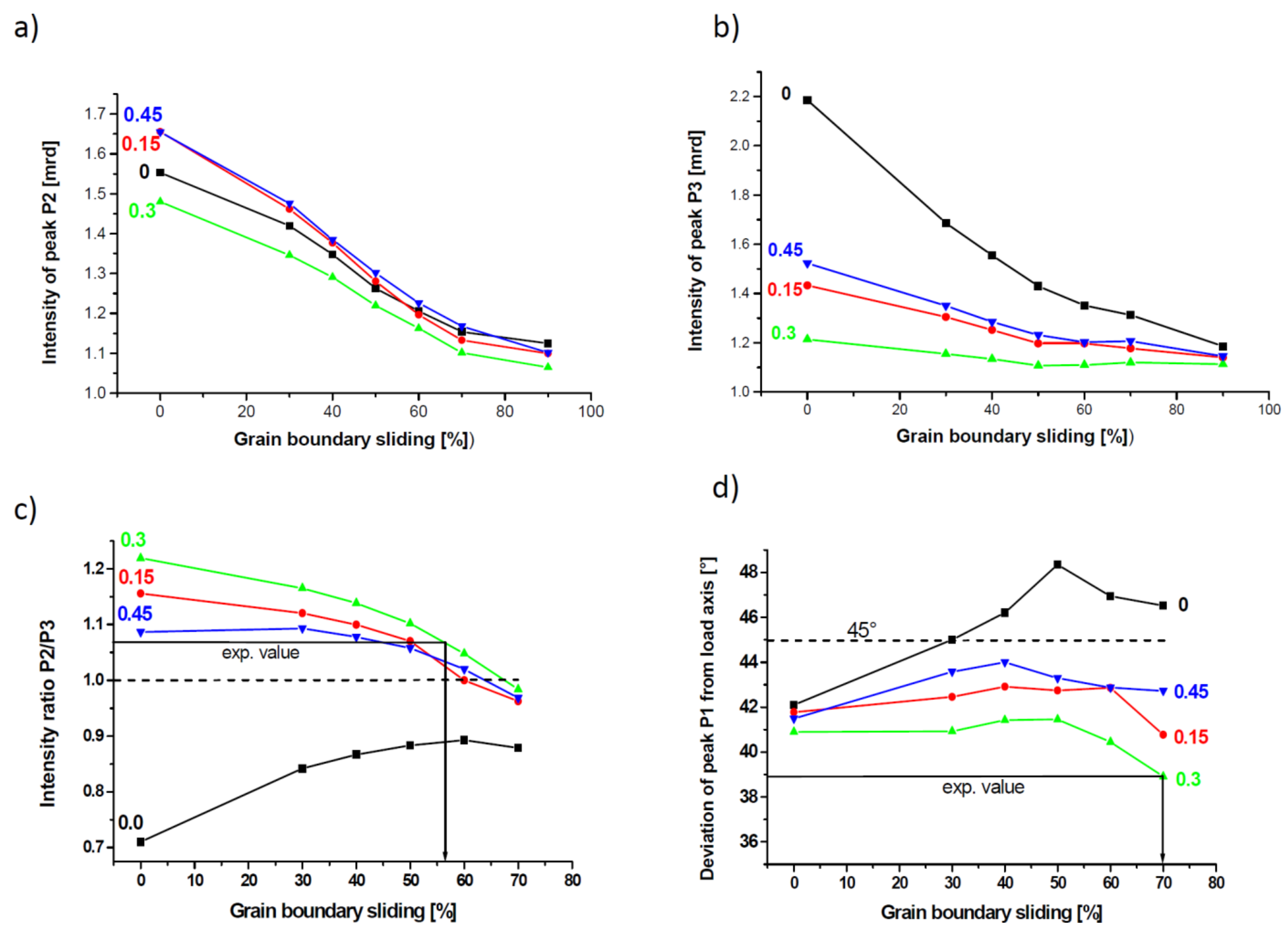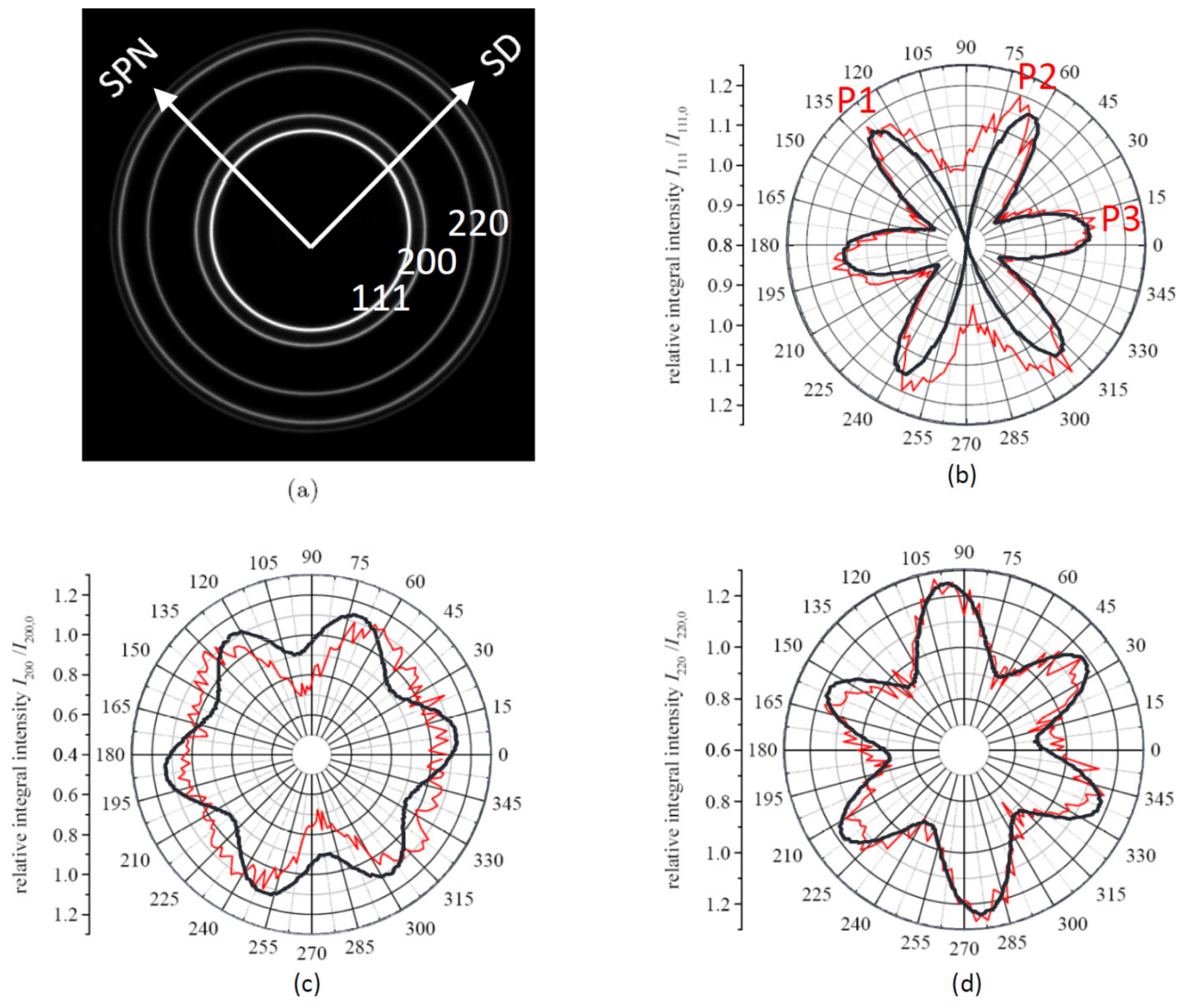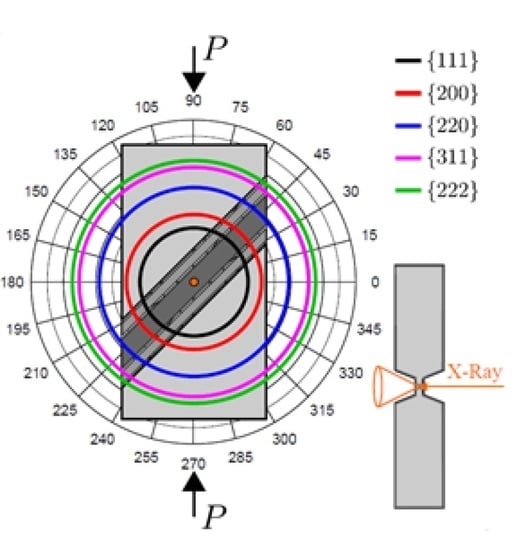2.1. Material, Deformation, and In-Situ X-ray Microdiffraction
The material system studied was an nc Pd–10 atom % Au alloy prepared by inert-gas condensation followed by powder compaction at a pressure of 2 GPa to disk-shaped samples with a diameter of 8 mm and a thickness in the range of 0.5–1.0 mm [
8]. The grain size distribution was lognormal and the texture was almost random [
1]. The area-averaged grain size determined by X-ray line profile analysis was about 15 nm [
1]. Note that the Pd–10 atom % Au alloy is a solid solution with a relatively high stacking fault energy of 150 mJ·m
−2 [
3].
Deformation was carried out on a small-scale specimen, the specific geometry of which is shown in
Figure 1. Such a specimen is termed shear compression specimen (SCS) [
9] and was cut by spark erosion from the as-prepared disk. Two parallel and oblique slits recessed on opposing faces formed the gauge section. The dimensions of the SCS were 7 mm × 0.95 mm × 0.77 mm (H × W × T). The gauge section was thinned to
h = 123 µm with a width of about
s = 120 µm (
Figure 1a). Applying a compression stress, the SCS was forced to shear along the gauge section oriented at 45° with respect to the compression axis (
Figure 1b). Since plastic deformation is confined to the gauge section [
10], the SCS is ideally suited for synchrotron radiation-based transmission experiments. Such experiments were done at the high energy micro-diffraction end-station of beamline ID15A at the European Synchrotron Radiation Facility (ESRF, Grenoble, France). Mechanical testing was performed by a tension/compression device from Kammrath–Weiss (Dortmund, Germany) made up of two load plungers moving symmetrically towards the center, thus keeping the gauge section in a fixed position relative to the incoming beam. The lower plunger was replaced by a roll bearing wagon to substantially reduce the friction coefficient of the horizontal sample movement that goes along with the enforced shear deformation (
Figure 1b) [
10]. The applied strain rate was about 10
−3 s
−1.
The sample deformation was recorded by a CCD camera from Pixelink (Ottawa, ON, Canada) using an inline microscope lens for magnification and several light sources to illuminate the sample. The images were processed by digital image correlation for extracting true sample displacements to establish load–displacement curves. As the gauge section of the SCS deforms under dominant simple shear but also under an appreciable superimposed plane strain compression, there are no simple formulas to compute stress–strain curves from load–displacement data. Instead, finite element analysis was employed using Abaqus to generate load–displacement curves that best approximated the experimental curves. More details on SCS testing are given in [
5,
11,
12].
The testing device with the installed SCS was mounted on top of a six-axis goniometer, which enables the exact placement of the sample with respect to the incoming synchrotron beam. The focused beam with a cross section of 8 µm × 20 µm was directed to the center of the thin gauge section, thus penetrating approximately 30 billion grains. The high energy X-ray radiation had a wavelength of λ = 0.0178 nm. To avoid shadowing of the scattering cones by the edges of the gauge slits, a trapezoid slit profile was used. The diffracted signal was recorded on a 2D-area detector (mar CCD), capable of recording one scan every seven seconds. The detector–sample distance was set to capture the first five Bragg reflections (Debye–Scherrer rings), so enabling a reasonable compromise between recording sufficiently high diffraction orders while still maintaining a good angular resolution. For data analysis, the 2D scans were averaged over 2°-wide polar segments to give 180 radial line scans, which were then fitted by split-Pearson-VII functions to obtain peak parameters such as the 2θ peak position, the integral intensity, and the integral peak width. For more details related to data reduction, see recent work by Lohmiller et al. [
11]. Because of the short wave length of the high energy synchrotron beam, the only grains that are diffracting are those that have the diffracting vector g (lattice plane normal) almost normal to the incoming beam direction (deviation Θ = arcsin (λ/2d
(hkl)): (111): 2.27°, (200): 2.62°, (220): 3.64°, with the Bragg angle Θ and lattice plane spacing d
(hkl)),
Figure 1c. It should also be mentioned that high monochromacy of the synchrotron radiation strongly reduces the fraction of grains in the Bragg condition. Thus, because of the high transmission, synchrotron radiation is an appropriate way to reach high grain statistics to a level reliable for measurements of weak textures, which is very important in the present texture analysis. Note that not all of the crystallographic texture was measured in the experiments because the sample was not rotated. Thus, since the specimen was not rotated, only low scattering angles of the diffraction circles were available, and this allowed for the determination of the peripheral parts of the pole figures only.
2.2. Texture Simulations
The texture development due to plastic strain was modeled using the Taylor viscoplastic polycrystal model. This uniform deformation polycrystal approach was justified in several previous studies of the present authors, which proved to be applicable to different nano-polycrystalline materials [
1,
6]. It was also found in those studies that the major operating slip mechanism was a <112> type partial dislocation slip on {111} planes. The usual {111}<110> slip systems were also considered in the simulations; the relative slip resistance of the two slip system families was kept at 1.5 during deformation (
). Strain hardening was not considered because nc materials do not show significant strain hardening. The slip rates
were connected to the resolved shear stresses
using the strain rate sensitive slip law of Hutchinson [
13]:
Here
is a reference rate and m is the strain rate sensitivity index for slip. A relatively high value was used for m (m = 1/6), which can be justified by (i) the rounding effect of the yield surface produced by viscoplastic slip [
14] and (ii) the enhanced strain rate sensitivity of nano-polycrystalline materials [
15].
Grain boundary sliding (GBS) was taken into account as an additional deformation mechanism of dislocation slip. For a quantitative simulation of the GBS process, the grain boundaries (GBS) were modeled by flat planes in 3D Cartesian space, by constructing a regular dodecahedron with 12 facets for each grain, with different initial positions (see more about the GBS modeling approach in [
7]). The deformation generates changes in the orientation of the GBS. To account for this important effect, the directions of the GB normals were updated by the sum of the rigid body rotations of the macroscopic velocity gradient and the one corresponding to the GBS. The constitutive law for GBS was taken similar to that of the slip, with the difference that linear viscous slip was assumed for GBS:
Although the GBS process is considered here linear viscous, considering that the crystallographic slip within the grains is non-linear (Equation (1)), the overall behavior is also non-linear. The resolved shear stress acting on the GBS was calculated from the macroscopic stress tensor
:
The Schmid-type GB orientation tensor was constructed from the GB normal and the GB-slip unit vectors: . The latter was assumed to be in the direction of the maximum resolved shear stress acting in the GB plane.
From the Schmid orientation tensor
and the sliding rate
of each GBS system, the velocity gradient
corresponding to the GBS of a grain can be calculated by
The grain interior is subjected to the difference between the macroscopically imposed and GBS-produced gradient tensor:
This velocity gradient was used to solve the crystal plasticity problem in full constraints Taylor deformation mode to obtain the slips in each slip system and then the lattice orientation change, from which the texture evolution can be calculated. Fifty thousand grains were considered in the simulations with initially perfectly random orientation distribution. The maximum applied compressive strain was 0.27, ideally yielding a maximum shear strain of 0.54. The texture simulations were done in strain steps of 0.01.
Note that the experiments were planned for simple shear tests; however, the experimental setup led to deviation from the ideal simple shear conditions. Namely, during compression, the length of the gauge section was reduced leading to an axial compression strain component. Therefore, additional to the ideal simple shear velocity gradient
, a plane strain type velocity gradient had to be considered:
As the simulations were done in the experimentally defined reference system, the following macroscopic velocity gradient tensor was used:
Here the first term on the right side is the simple shear part—operating at 45° with respect to the x–y–z reference system in the x–y plane—and the second part is the plane strain compression part, see
Figure 1 for the definition of the reference system. The effect of the compressive strain is very significant on the texture evolution, so its relative proportion to the shear was varied by the parameter
. The following values were employed: C = 0, 0.15, 0.3, and 0.45. Finite element simulations from [
16] suggested that the most probable value is C = 0.3. As shown below, our simulations indeed led to the best agreement with the experiments when C was 0.3.










